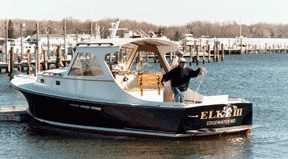Change of Life
Farewell to the wind — but not to the water
by Saul Friedman
My longtime sailing buddy, whom I shall call Richard, is struggling to come to terms with his change of life. But he doesn’t quite know it, which is why I’m not using his real name. It would be cruel and embarrassing to force the realization on him through this piece. I know what he’s going through, though, for I’ve been there myself.
This change of life comes when sailors of a certain age, mostly men but some women, realize they must give up wrestling with sheets, sails and winches and switch to a power boat. I suspect that’s happened or is happening now, not only to Richard, but to dozens of Bay Weekly readers, men who know they must contemplate life after sail, but won’t admit it — although their spouses are already there.
Let me make it clear that I don’t believe for a moment that hoary old saw that says the two happiest days of your life are when you buy a sailboat and when you sell it. I’ve loved when I bought and was sad when I sold, for both events were bookmarks in our lives.
Setting Out
My first sailboat, only 23 feet with a shallow draft, was a fine and forgiving teacher, for I simply got out and pushed when I went aground, which was too often even with the shoal-draft keel. With the help of my friend Richard, an experienced sailor, this kid from Brooklyn (and my wife, Evelyn, from landlocked Nebraska), learned the basics of tacking, jibing and handling sails in a blow. We learned to live those moments when we — and the boat — were doing everything right. But we learned that the shallow keel didn’t work well when we needed to make way upwind. So …
My daughters, who were on their way to college, told me they wouldn’t go if I didn’t buy the new 27-foot I coveted, with its deep keel, jib and Genoa and cozy well-equipped cabin. It was a modest boat by Annapolis standards, but it was our dream. And my wife cried when I called it Elke, her Hebrew name. In fact, finally getting such a boat and working to get it ready for the season one January day, inspired me, finally, to quit smoking cigarettes. That was in 1976 and, as subsequent events showed, that boat and that decision probably saved my life.
We had that boat for nearly 10 years and sailed it well and hard. I shall never forget that first long port tack, returning from St. Michael’s, when that deep, high performance keel sailed us where we were headed, directly into the Red No. 4 in the South River. Is there any greater feeling than holding the tiller loosely and gazing up at the slot, with perfectly trimmed sails, while the boat sails itself?
Moving Up and Moving On
The 31-foot sloop with the latest winged keel gave me speed, more room, the manly pleasure of holding a wheel — plus the luxuries for my spouse, who was getting tired of handling unruly jibs on bouncing decks. Elke II had furling gear, and the halyards as well as the sheets and the traveler lines were led aft. Not having to get out of the cockpit in rough seas was a godsend for Evelyn. Below, we had all the comforts. It was, we felt, the boat we could retire to.
But that wasn’t to be, for while we aged, the boat didn’t. She was fast, as I said, but she was also quick, and she needed a lot of fast and strenuous handling in a breeze.
Another thing that plagues sailors who own boats: When you call the people who, over winter, told you to call them to sail, they always seemed to have other things to do. We couldn’t depend on crew, except for Richard. Too often when I gazed out at the Bay from my home, I felt guilty and frustrated, for the boat lay dormant at the marina dock because I could get no crew.
That’s when and why my wife and I came reluctantly and sadly to the conclusion that we could no longer count on sailing alone, especially in foul weather. Once, when we were tacking in, rail down, into the river on the way home, we had to avoid a sunken Flying Scot, and my wife asked, “when are we going to get in?” I calmed her fears by joking, “What makes you think we’re going to get in?”
After 30 years of sailing with my wife, it became clear to me that it was getting too physically demanding on a windy day, when inevitable problems made for moments of panic. She never complained and loved sailing, but she never got over the fear that a heeling boat was going to turn over. Never mind about the laws of physics; I refused to put a heel-indicator on the boat because at 25 degrees or so, she’d want to get off.
More seriously, she and I were in our 70s when we came to terms with the changes in our lives. It was tough for me to clamber about the deck to take down sails in a hurry. Silently, I knew it was time.
More Power to Us
I wasn’t about to give up boating, although I couldn’t stand the thought of those go-fast Clorox bottles that come with blondes in bikinis. That’s when I talked to Joe Reid, of Mast & Mallet, one of the last great boat builders on the Bay. His boats, fiberglass over wood, were gems of tradition. They are the next best things of beauty to a boat under sail, and as I watched him build for others I coveted one of his boats. When I asked him to build one about 31 feet long for my wife and me, he agreed. We spent a year watching it being built, from keel up.
In the meantime, I sold the 31-footer to Richard, who knew the boat well. Through the winter of 2003, Richard owned a sailboat for the first time in his long sailing life. I hung around Mast & Mallet (when I wasn’t working at home as a columnist for a New York newspaper). On a cold February day, Evelyn and I took pictures and drank champagne as Elke III was carefully lowered into the water. The following day it snowed heavily, and I waited impatiently.
During March there were a few days to shake her down with the crew that built her. It took time to get used to power and speed and a wheel that was not as responsive as a sailboat wheel. I learned about a bow thruster, but feared I might never learn how to handle this powerboat and a reverse that actually worked. That’s when the learning process and my change of life took a turn, and at last, I will get to the point.
On the evening of March 31, as I was finishing up at the computer and sending my column to my editor, the mouse refused to move in my hand; I could not control the cursor and my right leg felt tired. I was hospitalized by the morning of April Fool’s Day. I had suffered a serious stroke that partially paralyzed my right arm and leg. To cut this short, if I had had the sailboat, I could never have expected to get back aboard to handle sails and sheets. But I kept a picture of Elke III on my wheelchair during weeks of therapy, and by summer’s end I was a boater again. In this the fourth year of my life change, Elke III is my therapy.
My body intervened to confirm my decision to come to terms with age and reality. I know people who are sailing into their 80s, and more power to them. But Richard and my former boat have grown older together. I don’t know how much longer his new knees can hold out on hard fiberglass decks. I wish him well, but the body will tell you, one way or the other, when it’s time.
Listen to it. If you have to go from sail to power, stay with class and good taste; a boat ought to be beautiful, rather than fast and flashy. These are lessons from a sailing life.
Saul Friedman of Annapolis is a columnist for Newsday. This is his first story for Bay Weekly.
